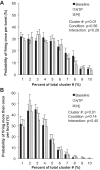Pharmacological assessment of the contribution of the arterial baroreflex to sympathetic discharge patterns in healthy humans
- PMID: 29488839
- PMCID: PMC6032124
- DOI: 10.1152/jn.00935.2017
Pharmacological assessment of the contribution of the arterial baroreflex to sympathetic discharge patterns in healthy humans
Abstract
To study how changes in baroreceptor afferent activity affect patterns of sympathetic neural activation, we manipulated arterial blood pressure with intravenous nitroprusside (NTP) and phenylephrine (PE) and measured action potential (AP) patterns with wavelet-based methodology. We hypothesized that 1) baroreflex unloading (NTP) would increase firing of low-threshold axons and recruitment of latent axons and 2) baroreflex loading (PE) would decrease firing of low-threshold axons. Heart rate (HR, ECG), arterial blood pressure (BP, brachial catheter), and muscle sympathetic nerve activity (MSNA, microneurography of peroneal nerve) were measured at baseline and during steady-state systemic, intravenous NTP (0.5-1.2 µg·kg-1·min-1, n = 13) or PE (0.2-1.0 µg·kg-1·min-1, n = 9) infusion. BP decreased and HR and integrated MSNA increased with NTP ( P < 0.01). AP incidence (326 ± 66 to 579 ± 129 APs/100 heartbeats) and AP content per integrated burst (8 ± 1 to 11 ± 2 APs/burst) increased with NTP ( P < 0.05). The firing probability of low-threshold axons increased with NTP, and recruitment of high-threshold axons was observed (22 ± 3 to 24 ± 3 max cluster number, 9 ± 1 to 11 ± 1 clusters/burst; P < 0.05). BP increased and HR and integrated MSNA decreased with PE ( P < 0.05). PE decreased AP incidence (406 ± 128 to 166 ± 42 APs/100 heartbeats) and resulted in fewer unique clusters (15 ± 2 to 9 ± 1 max cluster number, P < 0.05); components of an integrated burst (APs or clusters per burst) were not altered ( P > 0.05). These data support a hierarchical pattern of sympathetic neural activation during manipulation of baroreceptor afferent activity, with rate coding of active neurons playing the predominant role and recruitment/derecruitment of higher-threshold units occurring with steady-state hypotensive stress. NEW & NOTEWORTHY To study how changes in baroreceptor afferent activity affect patterns of sympathetic neural activation, we manipulated arterial blood pressure with intravenous nitroprusside and phenylephrine and measured sympathetic outflow with wavelet-based methodology. Baroreflex unloading increased sympathetic activity by increasing firing probability of low-threshold axons (rate coding) and recruiting new populations of high-threshold axons. Baroreflex loading decreased sympathetic activity by decreasing the firing probability of larger axons (derecruitment); however, the components of an integrated burst were unaffected.
Keywords: baroreflex; microneurography; modified Oxford technique; sympathetic outflow.
Figures







Similar articles
-
Interaction of simultaneous hypoxia and baroreflex loading on control of sympathetic action potential subpopulations.J Neurophysiol. 2024 Sep 1;132(3):1087-1097. doi: 10.1152/jn.00277.2024. Epub 2024 Aug 14. J Neurophysiol. 2024. PMID: 39140588
-
Arterial baroreflex regulation of muscle sympathetic single-unit activity in men: influence of resting blood pressure.Am J Physiol Heart Circ Physiol. 2020 Apr 1;318(4):H937-H946. doi: 10.1152/ajpheart.00700.2019. Epub 2020 Mar 6. Am J Physiol Heart Circ Physiol. 2020. PMID: 32142360
-
Inhibition of muscle sympathetic action potential firing and recruitment patterns following cannabis inhalation in humans.J Appl Physiol (1985). 2025 Jun 1;138(6):1425-1434. doi: 10.1152/japplphysiol.00135.2025. Epub 2025 May 17. J Appl Physiol (1985). 2025. PMID: 40380816
-
Action potential subpopulations within human muscle sympathetic nerve activity: Discharge properties and governing mechanisms.Auton Neurosci. 2021 Jan;230:102743. doi: 10.1016/j.autneu.2020.102743. Epub 2020 Nov 6. Auton Neurosci. 2021. PMID: 33202287 Review.
-
Peripheral and central mechanisms of baroreflex resetting.Clin Exp Pharmacol Physiol Suppl. 1989;15:31-43. doi: 10.1111/j.1440-1681.1989.tb02994.x. Clin Exp Pharmacol Physiol Suppl. 1989. PMID: 2680188 Review.
Cited by
-
A comparison of wavelet-based action potential detection from the NeuroAmp and the Iowa Bioengineering Nerve Traffic Analysis system.J Neurophysiol. 2024 Jun 1;131(6):1168-1174. doi: 10.1152/jn.00448.2023. Epub 2024 Apr 17. J Neurophysiol. 2024. PMID: 38629146 Free PMC article.
-
Effect of varying chemoreflex stress on sympathetic neural recruitment strategies during apnea.J Neurophysiol. 2019 Oct 1;122(4):1386-1396. doi: 10.1152/jn.00319.2019. Epub 2019 Aug 7. J Neurophysiol. 2019. PMID: 31389742 Free PMC article.
-
Muscle sympathetic single-unit response patterns during progressive muscle metaboreflex activation in young healthy adults.J Neurophysiol. 2020 Sep 1;124(3):682-690. doi: 10.1152/jn.00305.2020. Epub 2020 Jul 29. J Neurophysiol. 2020. PMID: 32727266 Free PMC article.
-
Interaction of simultaneous hypoxia and baroreflex loading on control of sympathetic action potential subpopulations.J Neurophysiol. 2024 Sep 1;132(3):1087-1097. doi: 10.1152/jn.00277.2024. Epub 2024 Aug 14. J Neurophysiol. 2024. PMID: 39140588
-
The role of the paravertebral ganglia in human sympathetic neural discharge patterns.J Physiol. 2018 Sep;596(18):4497-4510. doi: 10.1113/JP276440. Epub 2018 Aug 19. J Physiol. 2018. PMID: 30054928 Free PMC article.
References
-
- Badrov MB, Olver TD, Shoemaker JK. Central vs. peripheral determinants of sympathetic neural recruitment: insights from static handgrip exercise and postexercise circulatory occlusion. Am J Physiol Regul Integr Comp Physiol 311: R1013–R1021, 2016b. doi:10.1152/ajpregu.00360.2016. - DOI - PMC - PubMed
Publication types
MeSH terms
Substances
Grants and funding
LinkOut - more resources
Full Text Sources
Other Literature Sources
Miscellaneous

